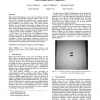Free Online Productivity Tools
i2Speak
i2Symbol
i2OCR
iTex2Img
iWeb2Print
iWeb2Shot
i2Type
iPdf2Split
iPdf2Merge
i2Bopomofo
i2Arabic
i2Style
i2Image
i2PDF
iLatex2Rtf
Sci2ools
VR
2011
IEEE
2011
IEEE
Shadow walking: An unencumbered locomotion technique for systems with under-floor projection
When viewed from below, a user’s feet cast shadows onto the floor screen of an under-floor projection system, such as a sixsided CAVE. Tracking those shadows with a camera provides enough information for calculating a user’s ground-plane location, foot orientation, and footstep events. We present Shadow Walking, an unencumbered locomotion technique that uses shadow tracking to sense a user’s walking direction and step speed. Shadow Walking affords virtual locomotion by detecting if a user is walking in place. In addition, Shadow Walking supports a sidestep gesture, similar to the iPhone’s pinch gesture. In this paper, we describe how we implemented Shadow Walking and present a preliminary assessment of our new locomotion technique. We have found Shadow Walking provides advantages of being unencumbered, inexpensive, and easy to implement compared to other walking-in-place approaches. It also has potential for extended gestures and multi-user locomotion.
| Added | 22 Aug 2011 |
| Updated | 22 Aug 2011 |
| Type | Journal |
| Year | 2011 |
| Where | VR |
| Authors | David J. Zielinski, Ryan P. McMahan, Rachel B. Brady |
Comments (0)

